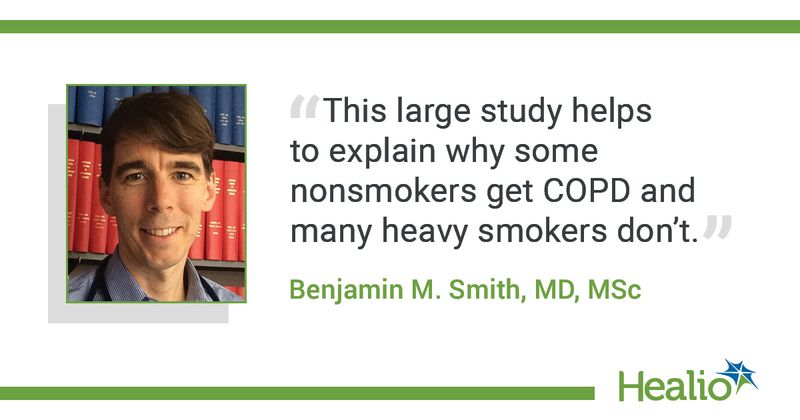Dysanapsis a risk factor for COPD in older adults
People with small airways relative to the size of their lungs may have a lower breathing capacity and, consequently, increased risk for COPD, even if they do not smoke or have other risk factors, according to a study published in JAMA.
“Dysanapsis refers to a mismatch between the size of the airway tree and lungs and is believed to arise early in life. Using multiple large cohorts from the U.S. and Canada, we showed that dysanapsis, measured directly by CT scan, was a major COPD risk factor — on par with cigarette smoking,” Benjamin M. Smith, MD, MSc, clinician-scientist and pulmonary physician in the department of medicine at Columbia University Irving Medical Center and McGill University Health Centre Research Institute, told Healio. “People with smaller airway trees relative to lung size tended to have lower lung function and higher COPD risk, even among never smokers. Conversely, lifelong heavy smokers who did not have COPD tended to have larger than expected airway trees relative to lung size.”

Researchers assessed community-based samples from the Multi-Ethnic Study of Atherosclerosis (MESA) lung study and the Canadian Cohort of Obstructive Lung Disease (CanCOLD) and the Subpopulations and Intermediate Outcome Measures in COPD Study (SPIROMICS) of smokers and nonsmokers with and without COPD.
The primary outcome was COPD defined by postbronchodilator ratio of FEV1 to FVC less than 0.7 with respiratory symptoms and the secondary outcome was longitudinal lung function.
In the MESA lung study, among 2,531 participants (52.7% women; mean age, 69 years) at six U.S. sites from 2010 to 2018, 9.4% had prevalent COPD. Mean airway to lung ratio was 0.033 and mean FEV1 decline was –33 mL per year. Among 2,294 participants without prevalent COPD in the MESA lung study, 4.3% had incident COPD at a median of 6.2 years. Participants in the lowest quartile of airway to lung ratio had significantly higher COPD incidence compared with those in the highest quartile, with 9.8 cases per 1,000 person-years vs. 1.2 cases per 1,000 person-years (adjusted RR = 8.12; 95% CI, 3.81-17.27). However, there was no significant difference in FEV1 decline between the highest and lowest quartiles of airway to lung ratio (–31 mL per year vs. –33 mL per year; 95% CI, –2 to 5).
In the CanCOLD study, among 1,272 participants (44.3% women; mean age, 67 years) at nine Canadian sites from 2010 to 2018, 15% had incident COPD at a median of 3.1 years and a mean FEV1 decline of –36 mL per year. Participants in the lowest quartile of airway to lung ratio had a significantly higher COPD incidence compared with those in the highest quartile, with 80.6 cases per 1,000 person-years vs. 24.2 cases per 1,000 person-years (RR = 3.33; 95% CI, 1.89-5.85). Again, there was no significant difference in FEV1 decline between the highest and lowest quartiles of airway to lung ratio (–34 vs. –36 mL per year; 95% CI, –15 to 16).
In the SPIROMICS study, among 1,206 participants with COPD (44.9% women; mean age, 65 years) at 12 U.S. sites from 2011 to 2016, mean FEV1 decline for those in the lowest quartile of airway to lung ratio was –37 mL per year, which the researchers noted was not significantly different than in the MESA lung study. Participants in the highest quartile had significantly faster FEV1 decline compared with participants in the MESA Lung sample (–55 mL per year; 95% CI, –32 to –3).
The researchers then evaluated participants from the CanCOLD study who never smoked (n = 520) and participants from SPIROMICS who smoked 20 or more pack-years (n = 2,726). Mean airway to lung ratio was 0.031 among the never smokers and 0.032 among the heavy smokers. In both groups, the researchers observed that lower airway to lung ratio was significantly associated with lower FEV1:FVC at baseline, higher COPD prevalence and higher COPD incidence.
“This large study helps to explain why some nonsmokers get COPD and many heavy smokers don’t,” Smith told Healio. “Dysanapsis appears to be a major COPD risk factor. Understanding the biological basis of dysanapsis may lead to early life interventions to promote the development of healthy and resilient lungs.”
The new study was funded in part by the National Heart, Lung, and Blood Institute (NHLBI).
“This work, stemming from the careful analysis of lung images of COPD patients, shows that an abnormal lung development may account for a large proportion of COPD risk among older adults,” James Kiley, PhD, director of the NHLBI division of lung diseases, said in a press release. “More research is needed to understand what drives this occurrence and to devise possible interventions.”
Reference:
For more information:
Benjamin M. Smith, MD, MSc, can be reached at benjamin.m.smith@mcgill.ca.
